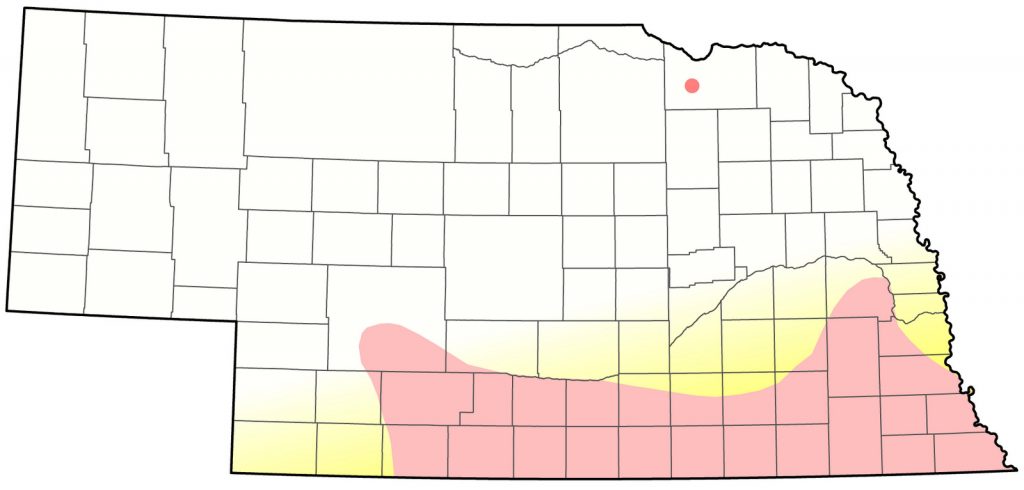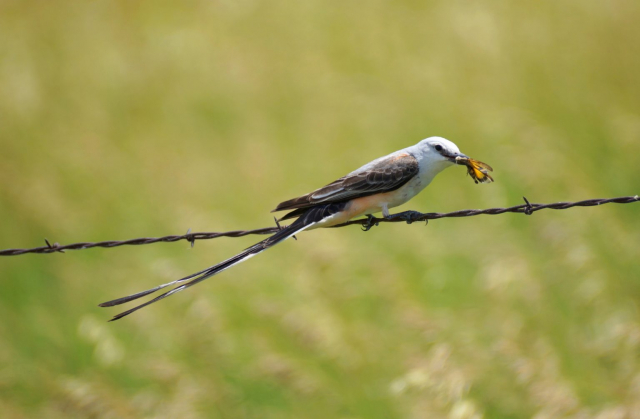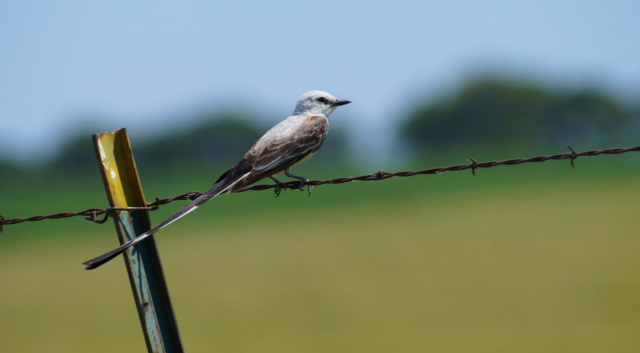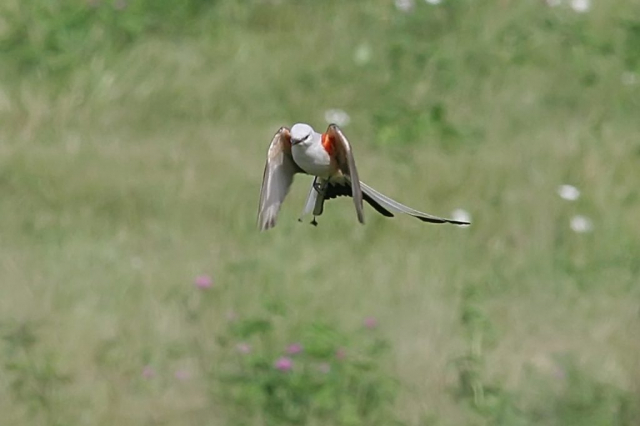Tyrannus forficatus
Status: Increasing. Rare regular breeder and spring visitor south of Platte River Valley, rare casual elsewhere. Rare casual summer and fall visitor statewide.

Documentation: Specimen: KU 34091, 9 Jul 1957 Thomas Co.
Taxonomy: A recent revision by Chesser et al (2018) changed the order of subfamilies within the Tyrannidae, placing Tyranninae (Nebraska-occurring genera Myiarchus, Pitangus, Tyrannus) ahead of Fluvicolinae (Nebraska-occurring genera Contopus, Empidonax, Sayornis, Pyrocephalus). We follow this order of genera.
No subspecies are recognized (AviList 2025).
Putative hybridization with Western Kingbird is discussed in Western Kingbird x Scissor-tailed Flycatcher.
Spring: Apr 21, 21, 21 <<<>>> summer
An earlier date is 9 Apr 2023 Lancaster Co.
There are northerly reports 5-17 May and probably the same bird still there 7 Jul 2024 Skyview Lake, Madison Co, 9 May 2014 Knox Co, 13 May 1982 Brown Co (Brogie and Mossman 1983), 30 May 1970 Rock Co (Menzel 1970), and 30 May 2024 Hutton Sanctuary, Rock Co. Most of these, or all until recently when breeding became regular in Nebraska, are spring overshoots; the species breeds commonly in the Kansas Flint Hills (Thompson et al 2011). WEsterly was one in Banner Co 4 May 2024.
Summer: Prior to 1945, reports of breeding were limited to two incidences of hybridization with Western Kingbird, in Logan and Lancaster Cos (see Taxonomy), a pair with at least two young near Hastings, Adams Co 7-8 Aug 1943 (Brooking 1943) and a nest with nestlings in Logan Co 9 Jul 1944 (Glandon 1945). Early sightings were from Adams Co 28 Apr 1928 and 2 Jul 1939 (Turner 1944). Swenk (1919) described this species as a “accidental visitor”.
The incidence of nesting in Nebraska, at the northern edge of the breeding range, may have been originally influenced by dry and wet precipitation cycles; the first 60 years of nesting records occurred in two periods, 1958-65 and 1989-91. Reports for the earlier period were of a pair in Gage Co observed 28 Jul-19 Aug 1958 which fledged young about 2 Aug (Sturmer 1959), a nest with young found in York Co (not Platte Co as cited by Ducey 1988) 16 Aug 1959 (Armstrong 1960), and a nest with eggshells below it found in Clay Co with birds observed in the area 1-26 Jun 1964 (Evans and Wolfe 1965). After a thirty-year gap with no known nesting, more recent breeding reports are of a pair which nested on a 15 m (50 ft) ballpark light standard in Cass Co in 1989 but abandoned the attempt 20 Jul (Cortelyou 1989), and adults seen with young in Cass Co 13-25 Aug 1991 (Morris 1992). An adult male associating with a shorter-tailed bird in Lancaster Co 16 Aug 1990 (Korpi 1991) may have bred in Nebraska.
Beginning in 2002, nesting has been reported every year, comprising 35 records at multiple locations in the south and southeast, possibly influenced increasingly by warming climate rather than precipitation cycles. These records, as well as additional reports without evidence of nesting, suggest that this species may breed anywhere south of the Platte River and east of the Panhandle, especially in counties north of the Kansas Flint Hills such as Gage, Jefferson, and Pawnee. More recently, however, nesting has been limited to an area along 626 Ave, Pawnee Co; a nest was at Klapka Tallgrass Prairie, about 800 m east of 626 on 28 Jun 2025.
A major surprise was a nesting attempt at Skyview Lake, Madison Co where one was carrying nest material 11-25 Jun 2025; at least one had summered there in 2024.
An apparent family group of 2-3 near Fremont, Dodge Co 13-24 Aug 2021 may not have summered there.
- Breeding Phenology:
Nest-building: 2-25 Jun
Eggs: 4 May- 7 Jul (Mollhoff 2022)
Nestlings: 9 Jul- 16 Aug
Fledglings: 11 Jul-25 Aug - An instance of possible double brooding was described by Mollhoff (2018).
Fall: summer <<<>>> Aug 16, 17, 19
Later dates are 24 Aug 1991 Cass Co, 24 Aug 2021 three Dodge Co, 29 Aug 2022 Jefferson Co, 13 Sep 2005 Antelope Co, 18 Sep 2005 Thomas Co, 20 Sep 2005 Cherry Co, 28 Sep 1965 Scotts Bluff Co (Cortelyou 1966), “first week in Oct” 1991 Fort Niobrara NWR, Cherry Co (Ricky Olson, personal communication), 2 Oct 1965 Lincoln Co (Cortelyou 1966), 12 Oct 2018 on Dawson-Buffalo Cos border, and one photographed 14 Oct 1981 in Garden Co (Silcock et al 1986).
Images
Abbreviations
KU: University of Kansas Natural History Museum
NWR: National Wildlife Refuge
Literature Cited
Armstrong, J.R. 1960. Letters to the editor. NBR 38: 56.
AviList Core Team, 2025. AviList: The Global Avian Checklist, v2025. https://doi.org/10.2173/avilist.v2025.
Brogie, M.A., and M.J. Mossman. 1983. Spring and summer birds of the Niobrara Valley Preserve. NBR 51: 44-51.
Brooking, A.M. 1943. Occurrence of the Scissor-tailed Flycatcher in Adams County. NBR 11: 48.
Chesser, R.T., K.J. Burns, C. Cicero, J.L. Dunn, A.W Kratter, I.J. Lovette, P.C. Rasmussen, J.V. Remsen, Jr., D.F. Stotz, B.M. Winger, and K. Winker. 2018. Fifty-ninth Supplement to the American Ornithological Society’s Check-list of North American Birds. Auk 135: 798-813. https://doi.org/10.1642/AUK-18-62.1.
Cortelyou, R.G. 1966. 1965 (Eighth) Fall Record Report. NBR 34: 50-58.
Cortelyou, R.G. 1989. Scissor-tailed Flycatcher nest in Cass County. NBR 57: 81-82.
Ducey, J.E. 1988. Nebraska birds, breeding status and distribution. Simmons-Boardman Books, Omaha, Nebraska, USA.
Evans, R.D., and C.W. Wolfe. 1965. Scissor-tailed Flycatcher nesting in Clay County. NBR 33: 14.
Glandon, E.W. 1945. Nesting of the Scissor-tailed Flycatcher in Logan County. NBR 13: 50-51.
Korpi, R.T. 1991. Fall 1990 Occurrence Report. NBR 59: 8-28.
Menzel, K.E. 1970. Scissor-tailed Flycatcher. NBR 38: 91.
Mollhoff, W.M. 2018. Possible double-brooding in Scissor-tailed Flycatcher (Tyrannus forficatus). Nebraska Bird Review 86: 128-130.
Mollhoff, W.J. 2022. Nest records of Nebraska birds. Nebraska Ornithologists’ Union Occasional Paper Number 9.
Morris, R. 1992. Fall 1991 Occurrence Report. NBR 60: 3-35.
Silcock, W.R., T.E. Bray, and B.K. Padelford. 1986. Records needed. NBR 54: 40-41.
Sturmer, M. 1959. Nesting of a Scissor-tailed Flycatcher in Gage County. NBR 27: 19-20.
Swenk, M.H. 1919. The Birds and Mammals of Nebraska. Contributions of the Department of Entomology No. 23. Lincoln, Nebraska.
Thompson, M.C., C.A. Ely, B. Gress, C. Otte, S.T. Patti, D. Seibel, and E.A. Young. 2011. Birds of Kansas. University Press of Kansas, Lawrence, Kansas, USA.
Turner, H. 1944. (Editor F. W. Haecker’s postscript to) Notes on the Scissor-tailed Flycatcher and Hawk Migration in Adams County. NBR 12: 42.
Recommended Citation
Silcock, W.R., and J.G. Jorgensen. 2025. Scissor-tailed Flycatcher (Tyrannus forficatus). In Birds of Nebraska — Online. www.BirdsofNebraska.org
Birds of Nebraska – Online
Updated 3 Sep 2025



